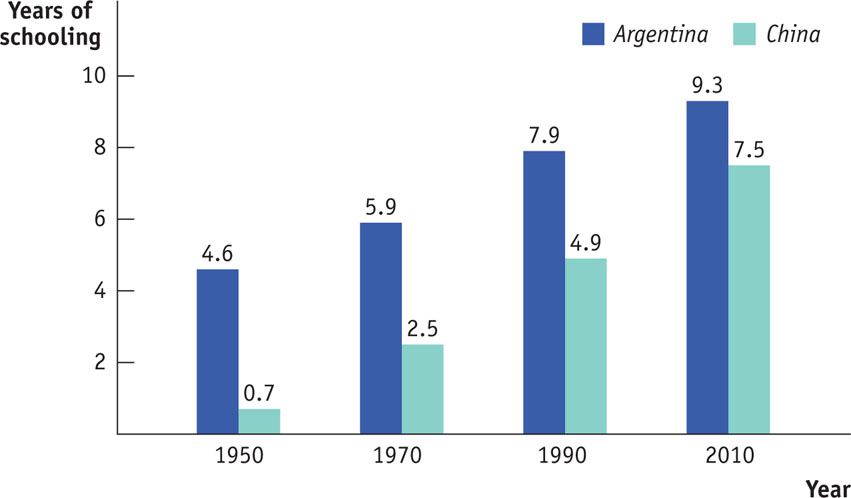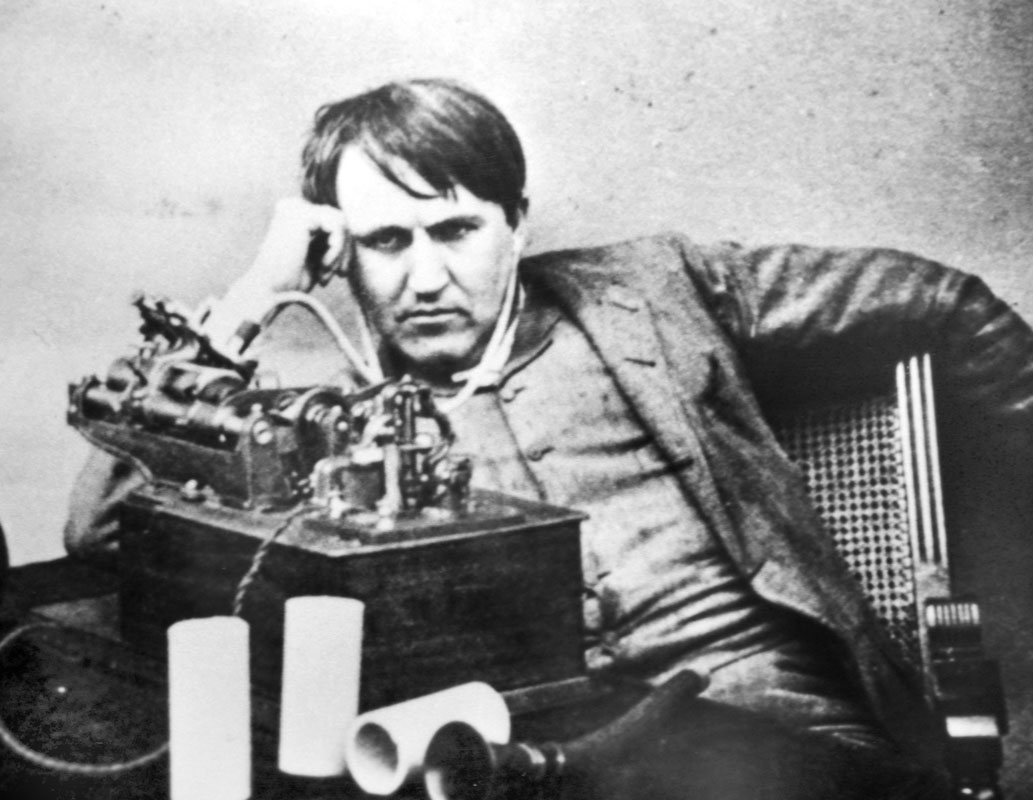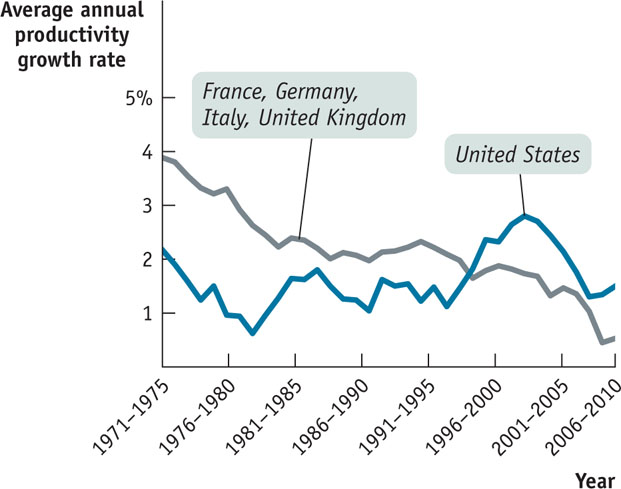Why Growth Rates Differ
In 1820, according to estimates by the economic historian Angus Maddison, Mexico had somewhat higher real GDP per capita than Japan. Today, Japan has higher real GDP per capita than most European nations and Mexico is a poor country, though by no means among the poorest. The difference? Over the long run—since 1820—real GDP per capita grew at 1.9% per year in Japan but at only 1.3% per year in Mexico.
As this example illustrates, even small differences in growth rates have large consequences over the long run. So why do growth rates differ across countries and across periods of time?
Explaining Differences in Growth Rates
As one might expect, economies with rapid growth tend to be economies that add physical capital, increase their human capital, or experience rapid technological progress. Striking economic success stories, like Japan in the 1950s and 1960s or China today, tend to be countries that do all three: that rapidly add to their physical capital through high savings and investment spending, upgrade their educational level, and make fast technological progress. Evidence also points to the importance of government policies, property rights, political stability, and good governance in fostering the sources of growth.
Savings and Investment Spending One reason for differences in growth rates between countries is that some countries are increasing their stock of physical capital much more rapidly than others, through high rates of investment spending. In the 1960s, Japan was the fastest-growing major economy; it also spent a much higher share of its GDP on investment goods than did other major economies. Today, China is the fastest-growing major economy, and it similarly spends a very large share of its GDP on investment goods. In 2010, investment spending was 38% of China’s GDP, compared with only 16% in the United States.
Where does the money for high investment spending come from? Investment spending must be paid for either out of savings from domestic households or by savings from foreign households—that is, an inflow of foreign capital.
Foreign capital has played an important role in the long-run economic growth of some countries, including the United States, which relied heavily on foreign funds during its early industrialization. For the most part, however, countries that invest a large share of their GDP are able to do so because they have high domestic savings. In fact, China in 2010 saved an even higher percentage of its GDP than it invested at home. The extra savings were invested abroad, largely in the United States.
One reason for differences in growth rates, then, is that countries add different amounts to their stocks of physical capital because they have different rates of savings and investment spending.
Education Just as countries differ substantially in the rate at which they add to their physical capital, there have been large differences in the rate at which countries add to their human capital through education.
A case in point is the comparison between Argentina and China. In both countries the average educational level has risen steadily over time, but it has risen much faster in China. Figure 13-7 shows the average years of education of adults in China, which we have highlighted as a spectacular example of long-run growth, and in Argentina, a country whose growth has been disappointing. Compared to China sixty years ago, Argentina had a much more educated population, while many Chinese were still illiterate. Today, the average educational level in China is still slightly below that in Argentina—but that’s mainly because there are still many elderly adults who never received basic education. In terms of secondary and tertiary education, China has outstripped once-rich Argentina.
FIGURE 13-7 China’s Students Are Catching Up

Research and Development The advance of technology is a key force behind economic growth. What drives technological progress?
Scientific advances make new technologies possible. To take the most spectacular example in today’s world, the semiconductor chip—which is the basis for all modern information technology—could not have been developed without the theory of quantum mechanics in physics.
Research and development, or R&D, is spending to create and implement new technologies.
But science alone is not enough: scientific knowledge must be translated into useful products and processes. And that often requires devoting a lot of resources to research and development, or R&D, spending to create new technologies and apply them to practical use.
Although some research and development is conducted by governments, much R&D is paid for by the private sector, as discussed below. The United States became the world’s leading economy in large part because American businesses were among the first to make systematic research and development a part of their operations. The upcoming For Inquiring Minds describes how Thomas Edison created the first modern industrial research laboratory.
Inventing R&D

Thomas Edison is best known as the inventor of the lightbulb and the phonograph. But his biggest invention may surprise you: he invented research and development.
Before Edison’s time, there had, of course, been many inventors. Some of them worked in teams. But in 1875 Edison created something new: his Menlo Park, New Jersey, laboratory. It employed 25 men full time to generate new products and processes for business. In other words, he did not set out to pursue a particular idea and then cash in. He created an organization whose purpose was to create new ideas year after year.
Edison’s Menlo Park lab is now a museum. “To name a few of the products that were developed in Menlo Park,” says the museum’s website, “we can list the following: the carbon button mouthpiece for the telephone, the phonograph, the incandescent light bulb and the electrical distribution system, the electric train, ore separation, the Edison effect bulb, early experiments in wireless, the grasshopper telegraph, and improvements in telegraphic transmission.”
You could say that before Edison’s lab, technology just sort of happened: people came up with ideas, but businesses didn’t plan to make continuous technological progress. Now R&D operations, often much bigger than Edison’s original team, are standard practice throughout the business world.
Developing new technology is one thing; applying it is another. There have often been notable differences in the pace at which different countries take advantage of new technologies. As this chapter’s Global Comparison shows, America’s surge in productivity growth after 1995, as firms learned to make use of information technology, was at least initially not matched in Europe.
The Role of Government in Promoting Economic Growth
Governments can play an important role in promoting—or blocking—all three sources of long-term economic growth: physical capital, human capital, and technological progress. They can either affect growth directly through subsidies to factors that enhance growth, or by creating an environment that either fosters or hinders growth.
Government Policies Government policies can increase the economy’s growth rate through four main channels.
Roads, power lines, ports, information networks, and other underpinnings for economic activity are known as infrastructure.
1. GOVERNMENT SUBSIDIES TO INFRASTRUCTURE Governments play an important direct role in building infrastructure: roads, power lines, ports, information networks, and other large-scale physical capital projects that provide a foundation for economic activity. Although some infrastructure is provided by private companies, much of it is either provided by the government or requires a great deal of government regulation and support. Ireland is often cited as an example of the importance of government-provided infrastructure. After the government invested in an excellent telecommunications infrastructure in the 1980s, Ireland became a favored location for high-technology companies from abroad and its economy took off in the 1990s.
Old Europe and New Technology
The United States experienced a burst of productivity growth after 1995, probably because businesses finally figured out how to use modern information technology effectively. As we’ll see in the Business Case on the “Walmart effect” that follows Chapter 14, the acceleration of technological progress was especially dramatic in distribution—that is, in the business of getting goods to consumers. But did the rest of the world experience a similar takeoff?
The answer is, not everywhere. This figure shows 5-year average rates of growth in labor productivity in the United States and in the four big economies of Western Europe—France, Germany, Italy, and the United Kingdom—from 1971 to 2010. Up until the mid-1990s, Europe consistently achieved higher productivity growth than did the United States. But in the years that followed, European growth declined as U.S. growth surged for a decade. By the mid-2000s, the U.S. productivity growth rate had reverted to the pre-information technology boom levels.
There is great dispute both about why much of Europe didn’t share in the productivity takeoff and about whether it will soon catch up to the United States. Some economists argue that high levels of government regulation made it hard for European businesses to reorganize themselves to take advantage of new technology. What is clear is that for at least a decade Europe lagged behind.

Poor infrastructure, such as a power grid that frequently fails and cuts off electricity, is a major obstacle to economic growth in many countries. To provide good infrastructure, an economy must not only be able to afford it, but it must also have the political discipline to maintain it.
Perhaps the most crucial infrastructure is something we, in an advanced country, rarely think about: basic public health measures in the form of a clean water supply and disease control. As we’ll see in the next section, poor health infrastructure is a major obstacle to economic growth in poor countries, especially those in Africa.
2. GOVERNMENT SUBSIDIES TO EDUCATION In contrast to physical capital, which is mainly created by private investment spending, much of an economy’s human capital is the result of government spending on education. Government pays for the great bulk of primary and secondary education. And it pays for a significant share of higher education: 75% of students attend public colleges and universities, and government significantly subsidizes research performed at private colleges and universities. As a result, differences in the rate at which countries add to their human capital largely reflect government policy. As we saw in Figure 13-7, educational levels in China are increasing much more rapidly than in Argentina. This isn’t because China is richer than Argentina; until recently, China was, on average, poorer than Argentina. Instead, it reflects the fact that the Chinese government has made education of the population a high priority.
3. GOVERNMENT SUBSIDIES TO R&D Technological progress is largely the result of private initiative. But in the more advanced countries, important R&D is done by government agencies as well. In the upcoming Economics in Action, we describe Brazil’s agricultural boom, which was made possible by government researchers who made discoveries that expanded the amount of arable land in Brazil, as well as developing new varieties of crops that flourish in Brazil’s climate.
4. MAINTAINING A WELL-FUNCTIONING FINANCIAL SYSTEM Governments play an important indirect role in making high rates of private investment spending possible. Both the amount of savings and the ability of an economy to direct savings into productive investment spending depend on the economy’s institutions, especially its financial system. In particular, a well-regulated and well-functioning financial system is very important for economic growth because in most countries it is the principal way in which savings are channeled into investment spending.
If a country’s citizens trust their banks, they will place their savings in bank deposits, which the banks will then lend to their business customers. But if people don’t trust their banks, they will hoard gold or foreign currency, keeping their savings in safe deposit boxes or under the mattress, where it cannot be turned into productive investment spending. As we’ll discuss later, a well-functioning financial system requires appropriate government regulation to assure depositors that their funds are protected from loss.
Protection of Property Rights Property rights are the rights of owners of valuable items to dispose of those items as they choose. A subset, intellectual property rights, are the rights of an innovator to accrue the rewards of her innovation. The state of property rights generally, and intellectual property rights in particular, are important factors in explaining differences in growth rates across economies. Why? Because no one would bother to spend the effort and resources required to innovate if someone else could appropriate that innovation and capture the rewards. So, for innovation to flourish, intellectual property rights must receive protection.
Sometimes this is accomplished by the nature of the innovation: it may be too difficult or expensive to copy. But, generally, the government has to protect intellectual property rights. A patent is a government-created temporary monopoly given to an innovator for the use or sale of his or her innovation. It’s a temporary rather than permanent monopoly because while it’s in society’s interests to give an innovator an incentive to invent, it’s also in society’s interests to eventually encourage competition.
Political Stability and Good Governance There’s not much point in investing in a business if rioting mobs are likely to destroy it, or saving your money if someone with political connections can steal it. Political stability and good governance (including the protection of property rights) are essential ingredients in fostering economic growth in the long run.
The New Growth Theory
Until the 1990s, economic models of technological progress assumed that what drove innovation was a mystery—unknown and unpredictable. In the words of economists, the sources of technological progress were exogenous—they were outside the models of economics and assumed to “just happen.” Then, in a series of influential papers written in the 1980s and 1990s, Paul Romer founded what we now call “the New Growth Theory.” In Romer’s model, technological progress was explainable because it was in fact endogenous—the outcome of economic variables and incentives. And because technological progress was endogenous, policies could be adopted to foster its growth.
At any point in time, an economy has a stock of knowledge capital—the accumulated knowledge generated by past investments in research and development, education, and skill enhancement, as well as knowledge acquired from other economies. And that stock of knowledge capital is spread throughout the economy, so all firms benefit from it. According to the New Growth Theory, a rising stock of knowledge capital creates the foundation for further technological progress as innovation, shared by firms throughout the economy, makes further innovation possible. For example, touchscreen technology—developed in the 1970s and 1980s—became the basis for later developments such as smartphones and tablet computers.
Yet, as Romer pointed out, there is a severe wrinkle in this story: because knowledge is shared throughout the economy, it may be very difficult for an innovator to capture the rewards of his or her innovation as others exploit the innovation for their own interests. So in the New Growth Theory, government protection of intellectual property rights is critical to furthering technological progress. In addition, governments, institutions, and firms can enhance technological progress by subsidizing investments in education and research and development, which, in turn, can increase the stock of knowledge capital.
By giving us a better model of where technological progress comes from, the New Growth Theory makes clear how important the policies of government, institutions, and firms are in fostering it.
Long-run economic growth in successful economies, like that of the United States, has been possible because there are good laws, institutions that enforce those laws, and a stable political system that maintains those institutions. The law must say that your property is really yours so that someone else can’t take it away. The courts and the police must be honest so that they can’t be bribed to ignore the law. And the political system must be stable so that laws don’t change capriciously.
Americans take these preconditions for granted, but they are by no means guaranteed. Aside from the disruption caused by war or revolution, many countries find that their economic growth suffers due to corruption among the government officials who should be enforcing the law. For example, until 1991 the Indian government imposed many bureaucratic restrictions on businesses, which often had to bribe government officials to get approval for even routine activities—a tax on business, in effect. Economists have argued that a reduction in this burden of corruption is one reason Indian growth has been much faster in recent years.
Even when the government isn’t corrupt, excessive government intervention can be a brake on economic growth. If large parts of the economy are supported by government subsidies, protected from imports, subject to unnecessary monopolization, or otherwise insulated from competition, productivity tends to suffer because of a lack of incentives. As we’ll see in the next section, excessive government intervention is one often-cited explanation for slow growth in Latin America.
The Brazilian Breadbasket
Awry Brazilian joke says that “Brazil is the country of the future—and always will be.” The world’s fifth most populous country has often been considered as a possible major economic power yet has never fulfilled that promise.

In recent years, however, Brazil’s economy has made a better showing, especially in agriculture. This success depends on exploiting a natural resource, the tropical savanna land known as the cerrado. Until a quarter-century ago, the land was considered unsuitable for farming. A combination of three factors changed that: technological progress due to research and development, improved economic policies, and greater physical capital.
The Brazilian Enterprise for Agricultural and Livestock Research, a government-run agency, developed the crucial technologies. It showed that adding lime and phosphorus made cerrado land productive, and it developed breeds of cattle and varieties of soybeans suited for the climate. (Now they’re working on wheat.) Also, until the 1980s, Brazilian international trade policies discouraged exports, as did an overvalued exchange rate that made the country’s goods more expensive to foreigners. After economic reform, investing in Brazilian agriculture became much more profitable and companies began putting in place the farm machinery, buildings, and other forms of physical capital needed to exploit the land.
What still limits Brazil’s growth? Infrastructure. According to a report in the New York Times, Brazilian farmers are “concerned about the lack of reliable highways, railways and barge routes, which adds to the cost of doing business.” Recognizing this, the Brazilian government is investing in infrastructure, and Brazilian agriculture is continuing to expand. The country has already overtaken the United States as the world’s largest beef exporter and may not be far behind in soybeans.
Quick Review
- Countries differ greatly in their growth rates of real GDP per capita due to differences in the rates at which they accumulate physical capital and human capital as well as differences in technological progress. A prime cause of differences in growth rates is differences in rates of domestic savings and investment spending as well as differences in education levels, and research and development, or R&D, levels. R&D largely drives technological progress.
- Government actions can promote or hinder the sources of long-term growth.
- Government policies that directly promote growth are subsidies to infrastructure, particularly public health infrastructure, subsidies to education, subsidies to R&D, and the maintenance of a well-functioning financial system.
- Governments improve the environment for growth by protecting property rights (particularly intellectual property rights through patents), by providing political stability, and through good governance. Poor governance includes corruption and excessive government intervention.
Check Your Understanding 13-3
Question
Which of the following statements correctly explains the link between a country’s growth rate, its investment spending as a percent of GDP, and its domestic savings?
A. B. C. D. A country that has high domestic savings is able to achieve a high rate of investment spending as a percent of GDP. This, in turn, allows the country to achieve a high growth rate.Question
U.S. centers of academic biotechnology research have closer connections with private biotechnology companies than do their European counterparts. What effect might this have on the pace of creation and development of new drugs in the United States versus Europe?
A. B. C. It is likely that the United States will experience a greater pace of creation and development of new drugs because closer links between private companies and academic research centers will lead to work more directly focused on producing new drugs rather than on pure research.Question
During the 1990s in the former U.S.S.R., a lot of property was seized and controlled by those in power. How might this have affected the country’s growth rate at that time?
A. B. C. It is likely that these events resulted in a fall in the country’s growth rate because the lack of property rights would have dissuaded people from making investments in productive capacity.
Solutions appear at back of book.